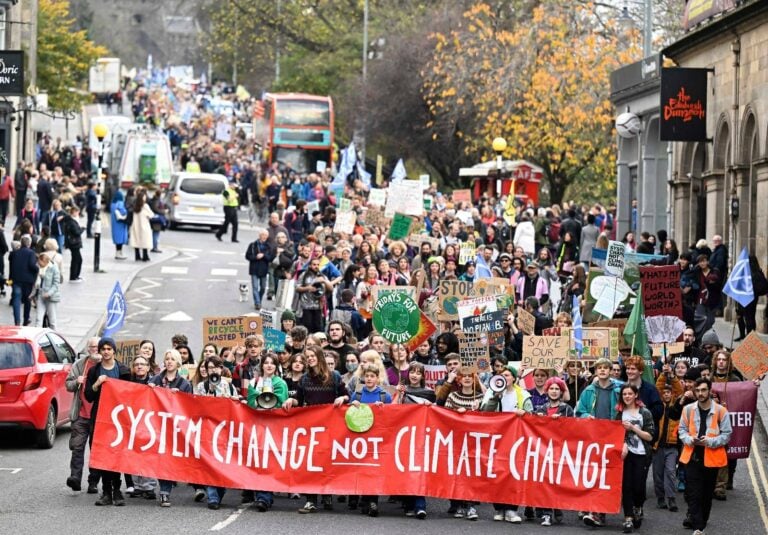
The politics of quantitative easing
A critical assesment of the harmful impact of European monetary policy on developing countries

A new age of debt crises in emerging economies is on the horizon. Debt levels have been rising across developing countries since the 2008 global financial crisis, on the back of favourable monetary policies in developed economies. The end of Quantitative Easing (QE) programmes and the rise in interest rates in developed economies are creating the conditions for a perfect storm. After a period of capital flows moving into developing countries, capital will be going back to developed economies. This will leave behind a predictable pattern of debt crises – with potentially devastating consequences.
This new report analyses the problems that monetary policies in developed economies pose for developing countries. Given the history of debt crises in emerging economies, with profound and long-lasting socio-economic and political consequences, we must be alert to signs of another emerging debt crisis.
Urgent action is needed to address this problem, including:
- reversing the global trend of liberalising capital controls
- introducing an internationally accepted debt restructuring arrangement
- preventing the abuse of debt crises by imposing a market-led restructuring programme.
What is QE?
Quantitative Easing (QE) is a monetary policy established by central banks in which newly created money is used to buy state debts (so-called ‘sovereign bonds’) or to buy corporations’ debts (‘corporate bonds’). The QE programmes were initiated to stabilise and revitalise the global economy after the 2008 financial crisis. From 2008 to 2018, the US, Japan and the Eurozone increased the money supply by US$12 trillion dollars through QE programmes.
However, QE has several negative consequences: it fuels wealth inequality; it increases the systemic risks of the global financial system, and it perpetuates an unsustainable debt-led economic model. This has a particularly severe consequence on emerging economies and the poorest developing countries.
QE has led to an increase in capital flows into developing regions and correspondingly a rise of foreign debt. For example, the stock of international bonds from Latin America and the Caribbean region increased from US$297 billion in 2009 to US$757 billion in 2017. In the Asia and Pacific region, the stock of international bonds increased from US$253 billion in 2009 to US$637 billion in 2017. Once the period of QE ends, these capital flows may reverse, leaving behind a stock of unpayable debts.
Consequences for developing countries
In the 1980s we saw debt crises in many parts of the developing world. This was followed by ‘Structural Adjustment Programmes’ of the World Bank and the IMF: in exchange for debt relief, indebted countries had to pursue austerity policies, privatise state enterprises and liberalise their economies. In the 1990s, global financial markets were further liberalised, creating opportunities for speculative funds to take advantage. This resulted in new debt crises in regions like East Asia. Recently we have also seen the handling of the Greek debt and the severe adjustment package imposed upon Greece.
The QE programmes have placed the financial world in a new phase, leading to the severe risk of another round of debt crises. The surplus of capital and low interest rates are leading to a rise in capital flows to developing countries. This money – in the form of buying government and corporate bonds – has gone to both states and private companies. In contrast to earlier decades, many of these bonds are held by institutional investors such as private pension funds, instead of private or government-backed banks. These investors look to these emerging economies because they can expect higher returns. However, as this money can be easily withdrawn due to the lack of capital controls, this results in ever larger and more aggressive fluctuations of cross-border capital flows. The money can flow in and out within seconds if the yield is bigger elsewhere.
This rising tide of capital flows, in particular in emerging economies, could result in a new period of ‘lost decades’, provoked by debt crises. The International Monetary Fund (IMF) has already issued a warning about very high debt levels for low-income countries. Many companies have very high rates of indebtedness. When investors in developed countries decide to withdraw their investments in emerging economies – due, for example, to higher interest rates – these companies may go bankrupt, which can result in a downward economic spiral.
In need of new debt restructuring mechanisms
The global financial architecture needs to be transformed to accommodate restrictions on capital movements and arrange for the bankruptcy of national states, or sovereign debt restructuring mechanisms (SDRM). The absence of an SDRM has led to an unacceptable breach of democratic processes over the last four decades. Developments in Greece since 2010 serve as a reminder of how in the absence of clear guidelines and obligations with respect to human rights and democracy, creditors can make a whole country pay the price.
History has shown that sovereign debt crises are a mechanism for generating private gains and public losses on a large scale. These crises have been exploited for market-oriented social and economic adjustment programmes since the 1980s. Given the increasing concentration in the market power of large multinational corporations, banks and financial institutions since the 1980s and in the face of growing global wealth inequality, this mechanism that feeds on crises must be addressed by an SDRM as a matter of urgency.
Discussions about both capital controls and SDRM as policy tools have been on the table for more than 40 years. It is high time to take a serious look at these ideas in the light of growing global liquidity propelled by QE policies. As the world enters a post-QE period, the global financial context seems to have become more destructive for developing countries than ever before. Now is the time for a new push towards establishing SDRM principles and for re-regulating capital movements.
What to do?
This report contains several detailed recommendations including:
- Central banks need to be more accountable and democratically governed.
- The mandate of the European Central Bank (ECB) (with a sole focus on price stability) should be broadened to include inclusive and sustainable environmental, economic and social goals.
- If QE is applied, there should be mechanisms to stop undue outflows to other economies (controls on outflowing capital). The price for the unintended effects should be paid by the country that implemented the QE instrument.
- Such mechanisms could include: third country cross-border transaction taxes; increased risk assessment methodologies before buying debt from developing countries; debt restructuring clauses in corporate bond contracts; supervisory intervention and caps on high exposure through asset managers to over-indebted countries.
- QE should come with conditions for banks, financial institutions and corporations whose assets are being bought by central banks. Such conditions could include lending or investing in the real economy in a socially and environmentally sustainable way and a ban or cap on speculative trading with the extra cash.
- If corporate bonds are part of the purchasing programme there needs to be an independent oversight mechanism.
- Capital controls for specific capital flows and re-regulating financial markets must be central issues in reforming the international financial architecture, to defend economies against the negative consequences of market-based finance and the speculative and herd-like behaviour of financial markets.
- Existing bilateral and multilateral trade and investment treaties need to be reconsidered. Their one-dimensional focus on the free movement of capital should be replaced by the right to a flexible use of capital controls adapted to the country and context.
Want to know more?
This report provides an in-depth analysis. It aims to inform non-governmental organisations (NGOs), academics and activists about the potentially harmful consequences of QE policies for developing countries. The authors – Rodrigo Fernandez, Pablo Bortz and Nicolas Zeolla – argue for a renewal of long-standing efforts to establish defence mechanisms in the current global economy to prevent future debt crises. Much of the groundwork has already been laid by NGOs, academics and activists working on international debt issues over the past three decades. QE requires an urgent acceleration of efforts to avoid past mistakes.
Do you need more information?
-

Rodrigo Fernandez
Senior researcher
Publication

Related news
-
Why share buybacks are bad for the planet and peoplePosted in category:Opinion
 Myriam Vander StichelePublished on:
Myriam Vander StichelePublished on: Myriam Vander Stichele
Myriam Vander Stichele -
 The trillion-dollar threat of climate change profiteersPosted in category:Long read
The trillion-dollar threat of climate change profiteersPosted in category:Long read Myriam Vander StichelePublished on:
Myriam Vander StichelePublished on: -
The treaty trap: The miners Published on:
 Vincent KiezebrinkPosted in category:Publication
Vincent KiezebrinkPosted in category:Publication Vincent Kiezebrink
Vincent Kiezebrink

